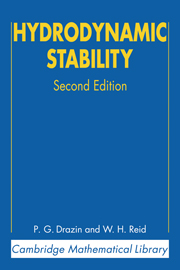3653 results in ebooks in fluid mechanics
Frontmatter
-
- Book:
- Internal Gravity Waves
- Published online:
- 05 October 2014
- Print publication:
- 02 September 2010, pp i-iv
-
- Chapter
- Export citation
4 - Nonlinear considerations
-
- Book:
- Internal Gravity Waves
- Published online:
- 05 October 2014
- Print publication:
- 02 September 2010, pp 213-261
-
- Chapter
- Export citation
2 - Interfacial waves
-
- Book:
- Internal Gravity Waves
- Published online:
- 05 October 2014
- Print publication:
- 02 September 2010, pp 74-140
-
- Chapter
- Export citation
Index
-
- Book:
- Internal Gravity Waves
- Published online:
- 05 October 2014
- Print publication:
- 02 September 2010, pp 367-377
-
- Chapter
- Export citation
A - Suggestions for further reading
-
- Book:
- Internal Gravity Waves
- Published online:
- 05 October 2014
- Print publication:
- 02 September 2010, pp 357-366
-
- Chapter
- Export citation
Index
-
- Book:
- Fundamentals of Engineering Numerical Analysis
- Published online:
- 05 June 2012
- Print publication:
- 23 August 2010, pp 235-241
-
- Chapter
- Export citation
1 - INTERPOLATION
-
- Book:
- Fundamentals of Engineering Numerical Analysis
- Published online:
- 05 June 2012
- Print publication:
- 23 August 2010, pp 1-12
-
- Chapter
- Export citation
4 - NUMERICAL SOLUTION OF ORDINARY DIFFERENTIAL EQUATIONS
-
- Book:
- Fundamentals of Engineering Numerical Analysis
- Published online:
- 05 June 2012
- Print publication:
- 23 August 2010, pp 48-100
-
- Chapter
- Export citation
Frontmatter
-
- Book:
- Fundamentals of Engineering Numerical Analysis
- Published online:
- 05 June 2012
- Print publication:
- 23 August 2010, pp i-iv
-
- Chapter
- Export citation
Preface to the First Edition
-
- Book:
- Fundamentals of Engineering Numerical Analysis
- Published online:
- 05 June 2012
- Print publication:
- 23 August 2010, pp xi-xiv
-
- Chapter
- Export citation
3 - NUMERICAL INTEGRATION
-
- Book:
- Fundamentals of Engineering Numerical Analysis
- Published online:
- 05 June 2012
- Print publication:
- 23 August 2010, pp 30-47
-
- Chapter
- Export citation
6 - DISCRETE TRANSFORM METHODS
-
- Book:
- Fundamentals of Engineering Numerical Analysis
- Published online:
- 05 June 2012
- Print publication:
- 23 August 2010, pp 167-226
-
- Chapter
- Export citation
A - A REVIEW OF LINEAR ALGEBRA
-
- Book:
- Fundamentals of Engineering Numerical Analysis
- Published online:
- 05 June 2012
- Print publication:
- 23 August 2010, pp 227-234
-
- Chapter
- Export citation
2 - NUMERICAL DIFFERENTIATION – FINITE DIFFERENCES
-
- Book:
- Fundamentals of Engineering Numerical Analysis
- Published online:
- 05 June 2012
- Print publication:
- 23 August 2010, pp 13-29
-
- Chapter
- Export citation
Contents
-
- Book:
- Fundamentals of Engineering Numerical Analysis
- Published online:
- 05 June 2012
- Print publication:
- 23 August 2010, pp v-vii
-
- Chapter
- Export citation
Preface to the Second Edition
-
- Book:
- Fundamentals of Engineering Numerical Analysis
- Published online:
- 05 June 2012
- Print publication:
- 23 August 2010, pp ix-x
-
- Chapter
- Export citation
5 - NUMERICAL SOLUTION OF PARTIAL DIFFERENTIAL EQUATIONS
-
- Book:
- Fundamentals of Engineering Numerical Analysis
- Published online:
- 05 June 2012
- Print publication:
- 23 August 2010, pp 101-166
-
- Chapter
- Export citation
Dedication
-
- Book:
- Fundamentals of Engineering Numerical Analysis
- Published online:
- 05 June 2012
- Print publication:
- 23 August 2010, pp viii-viii
-
- Chapter
- Export citation

Hydrodynamic Stability
-
- Published online:
- 06 August 2010
- Print publication:
- 05 August 2004
Contents
-
- Book:
- Gravity–Capillary Free-Surface Flows
- Published online:
- 07 September 2010
- Print publication:
- 15 July 2010, pp vii-x
-
- Chapter
- Export citation
